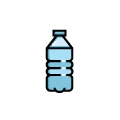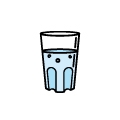
Effect
World’s First*¹ Clarification of Part of the
Inactivation Mechanism of SARS-CoV-2 by nanoe™ (Hydroxyl Radicals Contained in Water) Technology
Through collaborative research with Associate Professor Mayo Yasugi of the Graduate School of Veterinary Science, Osaka Metropolitan University, it has revealed for the first time that the structural collapse of the SARS-CoV-2 is one of the causes of the inactivation of the viruses through exposure to nanoe™.
nanoe™ destroys the viruses in pieces
nanoe™ comes in contact with the surface of viruses, damaging proteins on the cell surface including spike protein that get viruses bound to cells, as well as damaging the envelope.


Progressive degradation of proteins on the virus surface and damage to the envelop expand deformation. The envelope collapses.


Degradation of internal proteins including nucleocapsid proteins and viral genomic RNA. The virus is destroyed in pieces.


Which process does nanoe™ inhibit infection mechanism of SARS CoV-2?
The mechanism of SARS-CoV-2 infecting the cell

1. Virus approaches host cell

2. Virus binds to the host cell receptor

3. Virus invades in the host cell and replicates
What happens when nanoe™ exists?

1. Virus destroyed in pieces by nanoe™ effect

2. Virus destroyed in pieces cannot bind with cell

3. As no binding, the virus cannot invade into the cell and there is no infection
By nanoe™, certain viruses became less infectious
nanoe™ does not target specific molecules or structures of viruses, but damages SARS-CoV-2 by acting at multiple steps on the envelope, proteins, and genomic RNA that make up viruses. Viruses damaged by exposure to nanoe™ lose their ability to bind to host cell receptors, thereby becoming less infectious. These series of phenomena are considered to be part of the mechanism of how the SARS-CoV-2 is inactivated by nanoe™.
Paper about inactivation mechanism of SARS-CoV-2 by nanoe™
*1 As ion emission air purification technology (Panasonic data as of June 8, 2022)
Inhibits activity of airborne,
adhered bacteria1-3 & viruses4-6
Certain bacteria and viruses are far too small to see
The difference in size between a certain bacteria and viruses is about the same as the difference between apples and sesame seeds.

The virus survives different periods on different surfaces
Survival period varies depending on surface, from 3 hours to 7 days.
|
|
Type of substances |
Survival period |
|
|---|---|---|---|
|
|
Paper, tissue |
3 hours |
|
|
|
Copper surface* |
4 hours |
|
|
|
Cardboard surface |
24 hours |
|
|
|
Cloth surface |
2 days |
|
|
|
Plastic surface |
3 days |
|
|
|
Glass surface |
4 days |
|
|
|
Banknote surface |
4 days |
|
|
|
Outside of surgical mask |
7 days |
|
*Copper naturally degrades certain bacteria and viruses.
Survival period differs depending on surface irregularities.
Viruses survive longer on smooth surfaces than on irregular surfaces.
Source: https://www.businessinsider.com/coronavirus-lifespan-on-surfaces-graphic-2020-3
Effects on certain bacteria & viruses
Airborne bacteria
Staphylococcus aureus1

Airborne viruses
bacteriophageΦχ1744

Adhered bacteria
O1572

Adhered viruses
Influenza virus H1N1 subtype5

MRSA3

Poliovirus type1 (Lsc-2ab)6

How nanoe™ X works

nanoe™ X reaches virus.

Hydroxyl radicals denature virus proteins.

Virus activity is inhibited.1–6
1Airborne bacteria (Staphylococcus aureus). Testing organisation: Kitasato Research Center for Environmental Science. Testing method: The number of bacteria was measured after direct exposure in an approximately 25 m3-sized airtight test chamber. Inhibition method: nanoe™ released. Target substance: Airborne bacteria. Test result: Inhibited by at least 99.7% in 4 hours. (24_0301_1)
2Adhered bacteria (O157). Testing organisation: Japan Food Research Laboratories. Testing method: Measured the number of bacteria adhered to a cloth in an approximately 45 L-sized airtight test chamber. Inhibition method: nanoe™ released. Target substance: Adhered bacteria. Test result: Inhibited by at least 99.99% in 1 hour. (208120880_001)
3Adhered bacteria (MRSA). Testing organisation: Japan Food Research Laboratories. Testing method: Measured the number of bacteria adhered to a cloth in an approximately 45-L-sized airtight test chamber. Inhibition method: nanoe™ released. Target substance: Adhered bacteria. Test result: Inhibited by at least 99.99% in 1 hour. (208120880_002)
4Airborne viruses (bacteriophageΦχ174). Testing organisation: Kitasato Research Center for Environmental Science. Testing method: The number of viruses was measured after direct exposure in an approximately 25 m3-sized airtight test chamber. Inhibition method: nanoe™ released. Target substance: Airborne viruses. Test result: Inhibited by at least 99.7% in 6 hours. (24_0300_1)
5Adhered virus (Influenza virus H1N1 subtype). Testing organisation: Kitasato Research Center for Environmental Science. Testing method: Measured the number of viruses adhered to a cloth in an approximately 1 m3-sized airtight test chamber. Inhibition method: nanoe™ released. Target substance: Adhered viruses. Test result: Inhibited by at least 99.9% in 2 hours. (21_0084_1)
6Adhered viruses (Poliovirus type1(Lsc-2ab)). Testing organisation: Kitasato Research Center for Environmental Science. Testing method: Measured the number of viruses adhered to a cloth in an approximately 45 L-sized airtight test chamber. Inhibition method: nanoe™ released. Target substance: Adhered viruses. Test result: Inhibited by at least 99.7% in 2 hours. (22_0096)
Results may vary based on usage and seasonal and environmental variables (temperature and humidity). nanoe™ X and nanoe™ inhibit activity or growth of pollutants, but do not prevent illness.
Evidence
Viruses
nanoe™
|
|
Target |
Results*¹ |
Test space |
Exposure |
Testing organisation |
Report No. |
|
|---|---|---|---|---|---|---|---|
|
Adhering |
Novel coronavirus |
99.7% |
45 L |
3 |
Osaka Prefecture University |
|
|
|
Bird flu virus |
99.9% |
45 L |
4 |
Obihiro University of Agriculture |
|
||
|
Swine-origin influenza virus |
99% |
45 L |
6 |
||||
|
Influenza virus |
99.9% |
45 L |
4 |
Japan Food Research Laboratories |
208040534-001 |
||
|
99.9% |
1,000 L |
2 |
Kitasato Research Center |
21_0084_1 |
|||
|
Bacteriophage |
99.9% |
10,000 L |
24 |
Kitasato Research Center |
21_0143_4 |
||
|
99.8% |
Approx. |
8 |
Japan Food Research Laboratories |
13001265005-01 |
|||
|
Coxackievirus |
99.1% |
45 L |
2 |
Kitasato Research Center |
22_0085 |
||
|
Poliovirus type 1 |
99.7% |
45 L |
2 |
22_0096 |
|||
|
Encephalomyocarditis virus |
99.9% |
45 L |
6 |
Charles River Biopharmaceutical |
Virus clearance test |
||
|
Porcineparvovirus |
99.7% |
45 L |
6 |
||||
|
Xenotropic murine leukemia virus |
99.999% |
45 L |
6 |
||||
|
Pseudororabies virus |
99.9% |
45 L |
6 |
||||
|
Canine distemper virus |
99.7% |
45 L |
4 |
Rakuno Gakuen University, |
|
||
|
Canine parvovirus |
99.8% |
45 L |
6 |
||||
|
Canine herpesvirus |
99.5% |
45 L |
4 |
||||
|
Canine adenovirus |
99.4% |
45 L |
4 |
Yamaguchi University, |
|
||
|
Feline coronavirus |
99.3% |
45 L |
2 |
||||
|
Feline calicivirus |
99.9% |
25 L |
2 |
Japan Food Research Laboratories |
207031493-001 |
||
|
Airborne |
Bacteriophage |
99% |
1,000 L |
1.5 |
Kitasato Research Center |
20_0154_1 |
|
|
99.2% |
10,000 L |
4 |
21_0147 |
||||
|
99.74% |
Approx. |
6 |
24_0300_1 |
nanoe™ X
|
|
Target |
Results*¹ |
Test space |
Exposure |
Testing organisation |
Report No. |
|
|---|---|---|---|---|---|---|---|
|
Adhering |
Novel coronavirus |
99.7% |
45 L |
0.2 |
Osaka Prefecture University |
|
|
|
99.9% |
45 L |
0.2 |
Texcell |
1140-01 A1 |
|||
|
91.4% |
6.7 m³ |
0.5 |
1140-01 C3 |
||||
|
Bird flu virus |
99.9% |
45 L |
2 |
Obihiro University of Agriculture |
|
||
|
Swine-origin influenza virus |
99% |
45 L |
2 |
||||
|
Influenza virus |
99.9% |
1,000 L |
2 |
Kitasato Research Center |
21_0084_1 |
||
|
Bacteriophage |
99.9% |
10,000 L |
2 |
Kitasato Research Center |
21_0143_4 |
||
|
99.8% |
Approx. |
2 |
Japan Food Research Laboratories |
13001265005-01 |
|||
|
Coxackievirus |
99.1% |
45 L |
2 |
Kitasato Research Center |
22_0085 |
||
|
Poliovirus type 1 |
99.7% |
45 L |
2 |
22_0096 |
|||
|
Encephalomyocarditis virus |
99.9% |
45 L |
2 |
Charles River Biopharmaceutical |
Virus clearance test |
||
|
Porcineparvovirus |
99.7% |
45 L |
1 |
||||
|
Xenotropic murine leukemia virus |
99.999% |
45 L |
1 |
||||
|
Pseudororabies virus |
99.9% |
45 L |
6 |
||||
|
Canine distemper virus |
99.7% |
45 L |
4 |
Rakuno Gakuen University, |
|
||
|
Canine parvovirus |
99.8% |
45 L |
6 |
||||
|
Canine herpesvirus |
99.5% |
45 L |
4 |
||||
|
Canine adenovirus |
99.4% |
45 L |
4 |
Yamaguchi University, |
|
||
|
Feline coronavirus |
99.3% |
45 L |
2 |
||||
|
Feline calicivirus |
99.9% |
25 L |
2 |
Japan Food Research Laboratories |
207031493-001 |
||
|
Enterovirus 71 |
99.1% |
61 L |
4 |
Wuhan Institute of Virology, CAS |
MVCCC-2019/T4 |
||
|
99.9% |
61 L |
6 |
|||||
|
Coxsackievirus A16 |
99.3% |
61 L |
2 |
Wuhan Institute of Virology, CAS |
MVCCC-2019/T4 |
||
|
99.9% |
61 L |
4 |
|||||
|
Human coronavirus |
99.2% |
68 L |
4 |
China Electronic Product Reliability and Environmental Testing Research Institute |
J2003WT8888-00465 |
||
|
Airborne |
Bacteriophage |
99% |
1,000 L |
1.5 |
Kitasato Research Center |
20_0154_1 |
|
|
99.2% |
10,000 L |
4 |
21_0147 |
||||
|
99.2% |
Approx. |
6 |
24_0300_1 |
nanoe™ X (nanoe™ X Generator Mark 2)
|
|
Target |
Results*¹ |
Test space |
Exposure |
Testing organisation |
Report No. |
|
|---|---|---|---|---|---|---|---|
|
Adhering |
Enterovirus (EV71) |
99.9% |
30 m³ |
4 |
China Electronic Product Reliability and Environmental Testing Research Institute |
J2002WT8888-00439 |
|
|
Enterovirus (EV71) |
99.9% |
30 m³ |
6 |
China Electronic Product Reliability and Environmental Testing Research Institute |
J2002WT8888-00439 |
||
|
Enterovirus (EV71) |
97.6% |
30 m³ |
4 |
China Electronic Product Reliability and Environmental Testing Research Institute |
J1911WT8888-04860-01 |
||
|
Enterovirus (EV71) |
99.9% |
30 m³ |
6 |
China Electronic Product Reliability and Environmental Testing Research Institute |
J2003WT8888-00453 |
||
|
Coxsackie virus (CA16) |
99.9% |
30 m³ |
4 |
China Electronic Product Reliability and Environmental Testing Research Institute |
J2002WT8888-00439 |
||
|
Coxsackie virus (CA16) |
99.9% |
30 m³ |
6 |
China Electronic Product Reliability and Environmental Testing Research Institute |
J2002WT8888-00439 |
||
|
Coxsackie virus (CA16) |
95.4% |
30 m³ |
4 |
China Electronic Product Reliability and Environmental Testing Research Institute |
J1911WT8888-004860-02 |
||
|
Coxsackie virus (CA16) |
99.9% |
30 m³ |
6 |
China Electronic Product Reliability and Environmental Testing Research Institute |
J2003WT8888-00453 |
||
|
Coronavirus (HCoV-229E) |
99.9% |
30 m³ |
4 |
China Electronic Product Reliability and Environmental Testing Research Institute |
J2002WT8888-00544-01 |
||
|
Coronavirus (HCoV-229E) |
99.9% |
30 m³ |
4 |
China Electronic Product Reliability and Environmental Testing Research Institute |
J2003WT8888-00889 |
||
|
Herpes simplex virus |
99.9% |
30 m³ |
4 |
China Electronic Product Reliability and Environmental Testing Research Institute |
J2003WT8888-00889 |
||
|
Airborne |
Enterovirus (EV71) |
95.4% |
30 m³ |
1.5 |
China Electronic Product Reliability and Environmental Testing Research Institute |
J2002WT8888-00439 |
|
|
Enterovirus (EV71) |
96.9% |
30 m³ |
1.5 |
China Electronic Product Reliability and Environmental Testing Research Institute |
J2003WT8888-00889 |
||
|
Influenza virus (H1N1) |
95.4% |
30 m³ |
1.5 |
China Electronic Product Reliability and Environmental Testing Research Institute |
J2002WT8888-00439 |
||
|
Influenza virus (H1N1) |
98.3% |
30 m³ |
1.5 |
China Electronic Product Reliability and Environmental Testing Research Institute |
J2003WT8888-00889 |
nanoe™ X (nanoe™ X Generator Mark 3)
Bacteria
nanoe™
|
|
Target |
Results*¹ |
Test space |
Exposure |
Testing organisation |
Report No. |
|
|---|---|---|---|---|---|---|---|
|
Adhering |
Enterohemorrhagic Escherichia coli |
99.99% |
45 L |
1 |
Japan Food Research Laboratories |
208120880-001 |
|
|
99.99% |
45 L |
2 |
Eurofins |
2010/456-3 |
|||
|
Enterohemorrhagic |
99.99% |
45 L |
2 |
2010/456-4 |
|||
|
Methicillin-resistant Staphylococcus aureus |
99.99% |
45 L |
1 |
Japan Food Research Laboratories |
208120880-002 |
||
|
99.99% |
45 L |
1 |
Eurofins |
2010/456-1 |
|||
|
99.99% |
45 L |
2 |
Osaka Prefecture University |
|
|||
|
Escherichia coli |
99.99% |
45 L |
2 |
Panasonic Product Analysis Center |
E02-080303IN-01 |
||
|
Staphylococcus aureus |
99.99% |
1,000 L |
2 |
Kitasato Research Center |
20_0154_2 |
||
|
99.2% |
10,000 L |
2 |
Panasonic Product Analysis Center |
E02-090701IN-01 |
|||
|
99% |
10,000 L |
2 |
Japan Food Research Laboratories |
209071031-001 |
|||
|
99.1% |
Approx. |
2 |
13044083003-01 |
||||
|
99% |
Approx. |
1 |
SGS |
SHES160600431171 |
|||
|
Multiple-drug-resistant Pseudomonas aeruginosa |
99% |
45 L |
1 |
Toho University Faculty of Medicine, |
|
||
|
Multi-drug resistant Acinetobacter baumannii |
99% |
45 L |
2 |
||||
|
Bacillus |
99.7% |
45 L |
1 |
Japan Food Research Laboratories |
11000924001-01 |
||
|
Micrococcus |
99.9% |
45 L |
0.5 |
11000924001-02 |
|||
|
Serratia |
99.9% |
45 L |
0.5 |
11000924001-03 |
|||
|
Kocuria |
99.9% |
45 L |
0.5 |
11000922001-01 |
|||
|
methicillin-resistant staphylococcus pseudintermedius |
99.5% |
45 L |
0.5 |
Nippon Medical School, |
|
||
|
Bordetella bronchiseptica |
99.9% |
45 L |
0.5 |
||||
|
Pasteurella multocida |
99.9% |
45 L |
1 |
||||
|
Listeria monocytogenes |
99.9% |
45 L |
2 |
Osaka Prefecture University |
|
||
|
Bacillus subtilis |
99.9% |
45 L |
4 |
||||
|
Mycobacterium smegmatis |
99.9% |
45 L |
4 |
||||
|
Nocardia asteroids |
99.9% |
45 L |
4 |
||||
|
Neisseria gonorrhoeae |
99.9% |
45 L |
1 |
||||
|
Salmonella enterica |
99.9% |
45 L |
2 |
||||
|
Haemophilus influenza |
99.9% |
45 L |
1 |
||||
|
Campylobacter jejuni |
99.9% |
45 L |
4 |
||||
|
Airborne |
Staphylococcus aureus |
99.9% |
1,000 L |
0.34 |
Kitasato Research Center |
20_0154_1 |
|
|
99% |
10,000 L |
4 |
21_0142 |
||||
|
99.9% |
10,000 L |
3 |
21_0044 |
||||
|
99.7% |
Approx. |
4 |
24_0301_1 |
nanoe™ X
|
|
Target |
Results*¹ |
Test space |
Exposure |
Testing organisation |
Report No. |
|
|---|---|---|---|---|---|---|---|
|
Adhering |
Enterohemorrhagic Escherichia coli |
99.99% |
45 L |
1 |
Japan Food Research Laboratories |
208120880-001 |
|
|
99.9% |
45 L |
2 |
Eurofins |
2010/456-3 |
|||
|
Enterohemorrhagic |
99.99% |
45 L |
2 |
2010/456-4 |
|||
|
Methicillin-resistant Staphylococcus aureus |
99.99% |
45 L |
1 |
Japan Food Research Laboratories |
208120880-002 |
||
|
99.99% |
45 L |
1 |
Eurofins |
2010/456-1 |
|||
|
99.9% |
45 L |
2 |
Osaka Prefecture University |
|
|||
|
Escherichia coli |
99.9% |
45 L |
1 |
Panasonic Product Analysis Center |
E02-080303IN-01 |
||
|
Staphylococcus aureus |
99.99% |
1,000 L |
0.34 |
Kitasato Research Center |
20_0154_2 |
||
|
99.2% |
10,000 L |
24 |
Panasonic Product Analysis Center |
E02-090701IN-01 |
|||
|
99% |
10,000 L |
24 |
Japan Food Research Laboratories |
209071031-001 |
|||
|
99.1% |
Approx. |
8 |
13044083003-01 |
||||
|
99% |
Approx. |
8 |
SGS |
SHES160600431171 |
|||
|
99.91% |
24 m³ |
8 |
Panasonic Product Analysis Center |
1V332-170703-F04 |
|||
|
Multiple-drug-resistant Pseudomonas aeruginosa |
99% |
45 L |
2 |
Toho University Faculty of Medicine, |
|
||
|
Multi-drug resistant Acinetobacter baumannii |
99% |
45 L |
2 |
||||
|
Bacillus |
99.7% |
45 L |
0.5 |
Japan Food Research Laboratories |
11000924001-01 |
||
|
Micrococcus |
99.9% |
45 L |
2 |
11000924001-02 |
|||
|
Serratia |
99.9% |
45 L |
2 |
11000924001-03 |
|||
|
Kocuria |
99.9% |
45 L |
1 |
11000922001-01 |
|||
|
methicillin-resistant staphylococcus pseudintermedius |
99.5% |
45 L |
2 |
Nippon Medical School, |
|
||
|
Bordetella bronchiseptica |
99.9% |
45 L |
2 |
||||
|
Pasteurella multocida |
99.9% |
45 L |
1 |
||||
|
Listeria monocytogenes |
99.9% |
45 L |
2 |
Osaka Prefecture University |
|
||
|
Bacillus subtilis |
99.9% |
45 L |
4 |
||||
|
Mycobacterium smegmatis |
99.9% |
45 L |
4 |
||||
|
Nocardia asteroids |
99.9% |
45 L |
4 |
||||
|
Neisseria gonorrhoeae |
99.9% |
45 L |
1 |
||||
|
Salmonella enterica subsp. enterica |
99.9% |
45 L |
2 |
||||
|
Haemophilus influenza |
99.9% |
45 L |
1 |
||||
|
Campylobacter jejuni |
99.9% |
45 L |
4 |
||||
|
Airborne |
Staphylococcus aureus |
99.9% |
1,000 L |
0.34 |
Kitasato Research Center |
20_0154_1 |
|
|
99% |
10,000 L |
4 |
21_0142 |
||||
|
99.9% |
10,000 L |
3 |
21_0044 |
||||
|
99.7% |
Approx. |
4 |
24_0301_1 |
























